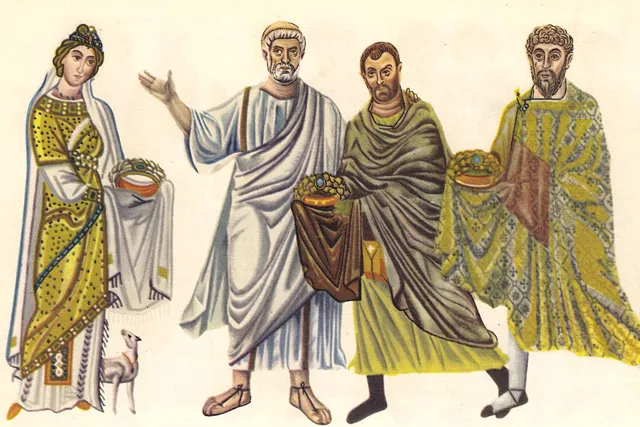Imagology: Towards the History of the Discipline
Imagology is a young academic discipline that studies how images of "other" ethnic and national communities are created, function, and are interpreted. Read about how imagology originated and the differences between Western and Russian approaches to this discipline in the article by historian Olga Berezina.
08.07.2025

Olga Berezina
Historian
The little-known word "imagology" is gradually making its way into historical works dedicated to studying images in the minds of people from the past. Its name is derived from the English word "image," meaning "the science of images," and it is associated with the study of national characters through the examination of images and stereotypes. As befits an interdisciplinary knowledge, imagology first manifested itself not in historical science but in literary studies. Even before the revolution, Russian literary scholar Alexander Nikolaevich Veselovsky used the imagological method in his research dedicated to the Italian Renaissance.
The first impetus for development within historical science came from the Annales School, represented by Marc Bloch and Lucien Febvre, who suggested that to study historical patterns, the focus should be on human consciousness and behavior.
Then, from the mid-20th century, a cognitive turn occurred in the humanities, where scholars began to explore the interconnections between the process of cognition and the mechanisms of the human psyche. At the same time, the constructivist theory gained popularity, formulated in Fredrik Barth's study "Ethnic Groups and Boundaries." According to it, nationality and ethnicity are social constructs that exist primarily in people's minds, and therefore should be studied with an allowance for subjective interpretations.
Currently, the leading figure in Western imagology is Joep Leerssen, author of "National Thought in Europe: A Cultural History." Leerssen centers his research not on objective ethnic characteristics but on an ethnic group's awareness of its own "self." Here, the classic imagological paradigm is born—the opposition of "Self and Other."
How does it work? As Leerssen writes: "We order the world primarily by dividing it, and the sense of collective unity inevitably generates a sense of collective otherness," meaning that understanding who we are arises from contrasting ourselves with the "Other." In everyday life, the "Other" is simply another person who differs from us in some characteristics. Through awareness of these differences, we understand ourselves. At higher levels of social organization, the "Other" consists of entire peoples who look, think, and live differently from us. Through the opposition of "Self and Other," peoples have contemplated their place in the world. From the reflections left by our predecessors, stereotypes are born that persist to this day.
Leerssen studied the representation of national images during the Romantic era, particularly through the Humboldt brothers, who explored the geography and cultures of peoples, and the Grimm brothers, who collected German folklore.
In Russian historiography, the study of national consciousness differs somewhat from Western methods and relies more on the analysis of literature, where stereotypes about national characters are presented in the most exaggerated form. Russian scholars, like Leerssen, trace the tradition of describing national characters from the Enlightenment era. In "Letters of a Russian Traveler" from the late 18th century, Nikolai Mikhailovich Karamzin first attempted to create images of the peoples he encountered during his travels in Europe, as well as to reflect on the perception of Russians abroad.
In Soviet historical science, the application of imagological approaches began in the 1970s with Leonid Abramovich Zak, who studied foreign policy stereotypes in his work "Monarchs Against Peoples: Diplomatic Struggle on the Ruins of the Napoleonic Empire." Zak analyzed Western theoretical approaches to studying images and applied them to the study of international relations, particularly the formation of state images, the influence of stereotypes on relations between countries, and the analysis of the conscious construction of images in diplomatic practice.
In the early 21st century, literary scholar Viktor Alexandrovich Khorev turned to the understanding of images of Polish nation representatives, publishing imagological collections such as "Poland and Poles through the Eyes of Russian Writers" and "Perception of Russia and Russian Literature by Polish Writers." In these, the author addresses the issue of "true and false perceptions of the lives of other peoples" using the example of Russian-Polish literary connections at the end of the 19th and beginning of the 20th centuries.
Contemporary historian Maria Voitovna Leskinen explores the formation of images and stereotypes about Poles and Finns in the science and culture of the Modern Age: "Myths and Images of Sarmatism: The Origins of the National Ideology of the Polish-Lithuanian Commonwealth," "Poles and Finns in Russian Science of the Second Half of the 19th Century: 'The Other' Through the Prism of Identity."
As we can see, Russian imagology is quite focused on Russian-Polish relations of the Modern Age. The coexistence of the two peoples in an extremely tense atmosphere of rivalry and cooperation has generated a whole body of imagological sources from both sides. Differences in religion, language, and lifestyle have formed a vast number of stereotypes. For Russian intellectuals of the Modern Age, describing Poland as a cultural antipode became a tool either for justifying Russian imperial policy or for condemning it.
In conclusion, it is worth noting that imagology also offers prospects for research concerning not only nations and ethnic groups but also smaller communities.
